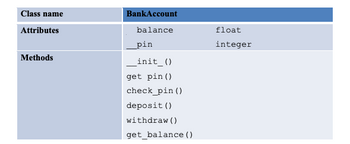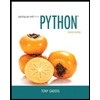
Focus on classes, objects, methods and good
Your task is to create a BankAccount class(See the pic attached)
The bank account will be protected by a 4-digit pin number (i.e. between 1000 and 9999). The pin should be generated randomly when the account object is created. The initial balance should be 0.
get_pin()should return the pin.
check_pin(pin) should check the argument against the saved pin and return True if it matches, False if it does not.
deposit(amount) should receive the amount as the argument, add the amount to the account and return the new balance.
withraw(amount) should check if the amount can be withdrawn (not more than is in the account), If so, remove the argument amount from the account and return the new balance if the transaction was successful. Return False if it was not.
get_balance() should return the current balance.
Finally, write a main() to demo your bank account class. Present a menu offering a few actions and perform the action the user requests, checking the pin where appropriate.
1. New Account – if selected, create a new account and tell the user the pin.
2. Deposit – if selected, prompt the user to input the pin, check the pin and then, if correct, prompt for the amount to deposit. Process the deposit and report the new balance
3. Withdraw – if selected, prompt the user to input the pin, check the pin and then, if correct, prompt for the amount to withdraw. Process the withdrawal and report the new balance or a message if the transaction was not successful.
4. Check balance – if selected, prompt the user to input the pin, check the pin and then, if correct, call the get_balance method and report the balance.
All printed output should be done in main(), not the methods.


Step by stepSolved in 4 steps

- Car Class Project The car classwill havethe following attributes: •year: an integer that holds the car's model year •model: a string that holds the make of the car •make: a string that holds the model of the car •speed: an integer that holds the car's current speed Your class should contain thefollowing: A docstring that briefly describes the class and lists the attributes. The docstring will serve as the documentation for your class. •A constructor (__init__ method) that takes the car's year model and make as optional arguments. The constructor will set the value of the speed attribute to 0.•An __str__ method that returns the car's year model and makein a string. •To test your class, create acar object and use the print function to verify that the constructor and __str__ methodsare working correctly. •An accessor method which returns the value stored in the speed instance variable. Call this method getSpeed(). •A modifier method called accelerate() which adds 5 to the speed variable…arrow_forwardA class object can encapsulate more than one [answer].arrow_forwardStockList Class • This class will contain the methods necessary to display various information about the stock data. • This class shall be a subclass of ArrayList. • This class shall not contain any data fields. (You don't need them for this class if done correctly). • This class shall have a default constructor with no parameters. o No other constructors are allowed. • This class shall have the following public, non-static, methods: • printAllStocks: This method shall take no parameters and return nothing. ▪ This method should print each stock in the StockList to an output file. ▪ NOTE: This method shall NOT print the data to the console. The output file shall be called all_stock_data.txt. The data should be printed in a nice and easy to read format. o displayFirstTenStocks: This method shall take no parameters and return nothing. ▪ This method should display only the first 10 stocks in the StockList in a nice and easy to read format. ▪ This method should display the data in the…arrow_forward
- class Duration: def __init__(self, hours, minutes): self.hours = hours self.minutes = minutes def __add__(self, other): total_hours = self.hours + other.hours total_minutes = self.minutes + other.minutes if total_minutes >= 60: total_hours += 1 total_minutes -= 60 return Duration(total_hours, total_minutes) first_trip = Duration(2, 58)second_trip = Duration(0, 49) first_time = first_trip + second_tripsecond_time = second_trip + second_trip print(first_time.hours, first_time.minutes)print(second_time.hours, second_time.minutes) what is the entire outputarrow_forwardAttributes item_name (string) item_price (int) item_quantity (int) Default constructor Initializes item's name="none", item's price = 0, item's quantity=0 Method print_item_cost() Ex of print_item_cost() output: Bottled Water 10 @ $1 = $10 in the main section of your code, prompt the user for two items and create two objects of the ItemToPurchase class. Exc Item 1 Enter the item name: Chocolate Chips Enter the item price: 3 Enter the item quantity: 1 Item 2 Enter the item name: Bottled Water Enter the item price: 1 Enter the item quantity: 10 Add the costs of the two items together and output the total cost Ex TOTAL COST Chocolate Chips 1 @ $3-$3 Bottled Water 10 @ $1= $10 Total: $13arrow_forwardA field has access that is somewhere between public and private. static final Opackage Oprotectedarrow_forward
- class Duration: def __init__(self, hours, minutes): self.hours = hours self.minutes = minutes def __add__(self, other): total_hours = self.hours + other.hours total_minutes = self.minutes + other.minutes if total_minutes >= 60: total_hours += 1 total_minutes -= 60 return Duration(total_hours, total_minutes) first_trip = Duration(3, 36)second_trip = Duration(0, 47) first_time = first_trip + second_tripsecond_time = second_trip + second_trip print(first_time.hours, first_time.minutes) what is the outputarrow_forwardclass Student: def __init__(self, id, fn, ln, dob, m='undefined'): self.id = id self.firstName = fn self.lastName = ln self.dateOfBirth = dob self.Major = m def set_id(self, newid): #This is known as setter self.id = newid def get_id(self): #This is known as a getter return self.id def set_fn(self, newfirstName): self.fn = newfirstName def get_fn(self): return self.fn def set_ln(self, newlastName): self.ln = newlastName def get_ln(self): return self.ln def set_dob(self, newdob): self.dob = newdob def get_dob(self): return self.dob def set_m(self, newMajor): self.m = newMajor def get_m(self): return self.m def print_student_info(self): print(f'{self.id} {self.firstName} {self.lastName} {self.dateOfBirth} {self.Major}')all_students = []id=100user_input = int(input("How many students: "))for x in range(user_input): firstName = input('Enter…arrow_forwardPortfolio Instructions: You are working for a financial advisor who creates portfolios of financial securities for his clients. A portfolio is a conglomeration of various financial assets, such as stocks and bonds, that together create a balanced collection of investments. When the financial advisor makes a purchase of securities on behalf of a client, a single transaction can include multiple shares of stock or multiple bonds. It is your job to create an object-oriented application that will allow the financial advisor to maintain the portfolios for his/her clients. You will need to create several classes to maintain this information: Security, Stock, Bond, Portfolio, and Date. The characteristics of stocks and bonds in a portfolio are shown below: Stocks: Bonds: Purchase date (Date) Purchase date (Date) Purchase price (double)…arrow_forward
- Car Class Project The car classwill havethe following attributes: •year: an integer that holds the car's model year •model: a string that holds the make of the car •make: a string that holds the model of the car •speed: an integer that holds the car's current speed Your class should contain thefollowing: A docstring that briefly describes the class and lists the attributes. The docstring will serve as the documentation for your class. •A constructor (__init__ method) that takes the car's year model and make as optional arguments. The constructor will set the value of the speed attribute to 0.•An __str__ method that returns the car's year model and makein a string. •To test your class, create acar object and use the print function to verify that the constructor and __str__ methodsare working correctly. •An accessor method which returns the value stored in the speed instance variable. Call this method getSpeed(). •A modifier method called accelerate() which adds 5 to the speed variable…arrow_forwardCode should be in Pythonarrow_forwardCharge Account ValidationCreate a class with a method that accepts a charge account number as its argument. The method should determine whether the number is valid by comparing it to the following list of valid charge account numbers:5658845 4520125 7895122 8777541 8451277 13028508080152 4562555 5552012 5050552 7825877 12502551005231 6545231 3852085 7576651 7881200 4581002These numbers should be stored in an array. Use a sequential search to locate the number passed as an argument. If the number is in the array, the method should return true, indicating the number is valid. If the number is not in the array, the method should return false, indicating the number is invalid.Write a program that tests the class by asking the user to enter a charge account number. The program should display a message indicating whether the number is valid or invalid.arrow_forward
 Database System ConceptsComputer ScienceISBN:9780078022159Author:Abraham Silberschatz Professor, Henry F. Korth, S. SudarshanPublisher:McGraw-Hill Education
Database System ConceptsComputer ScienceISBN:9780078022159Author:Abraham Silberschatz Professor, Henry F. Korth, S. SudarshanPublisher:McGraw-Hill Education Starting Out with Python (4th Edition)Computer ScienceISBN:9780134444321Author:Tony GaddisPublisher:PEARSON
Starting Out with Python (4th Edition)Computer ScienceISBN:9780134444321Author:Tony GaddisPublisher:PEARSON Digital Fundamentals (11th Edition)Computer ScienceISBN:9780132737968Author:Thomas L. FloydPublisher:PEARSON
Digital Fundamentals (11th Edition)Computer ScienceISBN:9780132737968Author:Thomas L. FloydPublisher:PEARSON C How to Program (8th Edition)Computer ScienceISBN:9780133976892Author:Paul J. Deitel, Harvey DeitelPublisher:PEARSON
C How to Program (8th Edition)Computer ScienceISBN:9780133976892Author:Paul J. Deitel, Harvey DeitelPublisher:PEARSON Database Systems: Design, Implementation, & Manag...Computer ScienceISBN:9781337627900Author:Carlos Coronel, Steven MorrisPublisher:Cengage Learning
Database Systems: Design, Implementation, & Manag...Computer ScienceISBN:9781337627900Author:Carlos Coronel, Steven MorrisPublisher:Cengage Learning Programmable Logic ControllersComputer ScienceISBN:9780073373843Author:Frank D. PetruzellaPublisher:McGraw-Hill Education
Programmable Logic ControllersComputer ScienceISBN:9780073373843Author:Frank D. PetruzellaPublisher:McGraw-Hill Education





